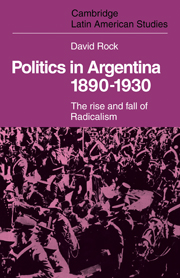Book contents
- Frontmatter
- Contents
- Preface
- 1 The components of Argentine society, 1890–1914
- 2 The oligarchy and institutional reform, 1880–1916
- 3 The rise of Radicalism, 1891–1916
- 4 The workers and their politics in Buenos Aires, 1890–1916
- 5 The first Radical government, 1916–22
- 6 The strikes, 1916–18
- 7 The Semana Trágica
- 8 1919
- 9 Postscript to the first presidency, 1920–2
- 10 The Alvear interlude, 1922–8
- 11 Yrigoyen's second presidency, 1928–30
- 12 Perspectives
- APPENDIXES
- 1 The occupational and class structure of the male population of the city of Buenos Aires by nationality, 1914
- 2 The rise of Radicalism – an historiographical note
- 3 The first Radical government and the Argentine Rural Society
- 4 The working class vote for the Radical and yrigoyenista parties in selected areas of Buenos Aires, 1912–30
- Select bibliography
- Index
- Frontmatter
- Contents
- Preface
- 1 The components of Argentine society, 1890–1914
- 2 The oligarchy and institutional reform, 1880–1916
- 3 The rise of Radicalism, 1891–1916
- 4 The workers and their politics in Buenos Aires, 1890–1916
- 5 The first Radical government, 1916–22
- 6 The strikes, 1916–18
- 7 The Semana Trágica
- 8 1919
- 9 Postscript to the first presidency, 1920–2
- 10 The Alvear interlude, 1922–8
- 11 Yrigoyen's second presidency, 1928–30
- 12 Perspectives
- APPENDIXES
- 1 The occupational and class structure of the male population of the city of Buenos Aires by nationality, 1914
- 2 The rise of Radicalism – an historiographical note
- 3 The first Radical government and the Argentine Rural Society
- 4 The working class vote for the Radical and yrigoyenista parties in selected areas of Buenos Aires, 1912–30
- Select bibliography
- Index
Summary
This chapter is a detailed examination of the Radical government's labour policies. It analyses the main points of contact between the administration and different groups of workers, attempting to develop an interpretative scheme illustrating the main factors and calculations underlying the relationship. It shows that the government did not indiscriminately take the side of the workers, but only tended to do so when such action promised political pay-offs, usually in voting terms. The aim also is to show how the relationship was challenged and modified by different employer groups, and the way they sought to develop contacts with powerful lobby groups to mobilise political support in their favour. This also raises the question of the political influence of major foreign companies in Argentina during this period. The general trend of events is that after a few early successes in 1917, the government found its policies triggering increasing opposition among the employer and lobby groups, the outcome of which was a formal alliance between domestic and foreign business interests. This presaged the major political crises of 1919.
Because both the Radicals themselves and many of the workers had no interest in legislation, and because the government did not control Congress, contact between government and the workers occurred almost exclusively during strikes. The government's actions on the strike front serve to illustrate the general objectives and the strategic details of its working class policy.
- Type
- Chapter
- Information
- Politics in Argentina, 1890–1930The Rise and Fall of Radicalism, pp. 125 - 156Publisher: Cambridge University PressPrint publication year: 1975
- 1
- Cited by

